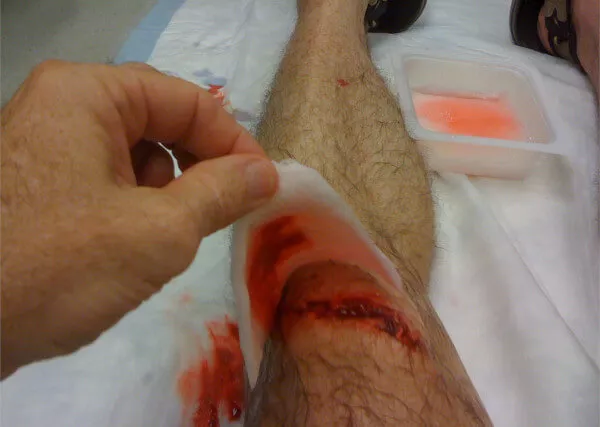Management of Complex limb injuries is always a challenging experience. Each case has to be individualized to obtain a satisfactory result.
To understand this better one has to have a clear understanding of the basic limb anatomy. In its most simplistic form limbs are composed of five major structures
Skin which provides – Cover
Blood Vessels which provides – Vascularity
Nerves which provides – Sensation / Motor innervation
Bones which provides – Stability
Tendons / Muscles providing - Movement
Simple Injury is one in which one or more of the above structures are transected.
Complex Injury is one in which one or more of the above structures are lost.
Complex injuries come in varying grades in which loss of major structures range from one to all the five elements mentioned above. If only one element is lost it is a reasonably straight forward procedure these days to replace the lost element by microsurgical free tissue transfer. But when more than one of the above structures is lost the situation gets more challenging.
The basic principle in achieving a successful outcome in these cases is to ANATOMICALLY reconstruct ALL the lost tissues to achieve PRIMARY healing within a LIMITED period.
In the olden days these sort of injuries were treated by one of the three methods – Amputation, long term dressings or by putting the limb in a plaster cast. Amputation is a quick simple option, but in this modern age with lots of sophisticated techniques available one should think twice before chopping someone’s limb off (This does not imply that ALL crushed limbs can be salvaged). Putting a crushed limb in a cast and forgetting about it was a popular practice with the orthopedic surgeons especially during the Second World War. This was due to the extremely large number of casualties and the fact that very few reconstructive surgeons were available those days. The third technique was to keep on dressing the wound with bedside debridement hoping for the wound to granulate ad then put a graft on it.
Patients managed by these techniques had two outcomes – If they were lucky the limb rotted and died!!! Or the limb survived, but with severe handicaps. The handicaps occurred as ALL the lost tissues were NOT ANATOMICALLY reconstructed and they healed by SECONDARY (Not Iry) intention in a PROLONGED (Not limited) period of time. The handicaps were
Skin / Soft Tissue providing Cover was not reconstructed it led to
UNSTABLE Scar –
Repeated breakdown
Infection
Pain
Discharge
Malignancy (Marjorlin’s ulcer)
If the BONE was not properly reconstructed it led to
C/C osteomyelitis
Discharging sinus
Infection
Pain
Foul smell
Marjorlin’s Ulcer
If the VESSELS are not reconstructed the limb might still survive but with
Significant ischemia
Exercise intolerance
Cold insensitivity
Tip necrosis / gangrene
If the NERVES are not reconstructed it will lead to
Motor deficit
Insensate Limb
Parasthesia / Hyperesthesia
Pain
Repeated trauma / burns leading to breakdowns
To avoid these problems and to achieve a successful outcome one needs to have a definitive game plan. To look at this very simplistically the plan should be
EARLY RADICAL DEBRIDEMENT
EARLY RECONSTRUCTION
- REPLACING ALL LOST STRUCTURES
- WITH LIKE STRUCTURES (Anatomical)
- ACHIEVE PRIMARY HEALING
- WITHIN A LIMITED PERIOD
This was first proven scientifically by Godina et al in their paper. He showed a flap failure rate of 0.75% and Infection rate of 1.5% when done within 72 hours after which it went up to 20% and 40% respectively.
This was followed by another paper by Bird et al. Soon paper after paper was published all echoing the same sentiments.
When we talk of DEBRIDEMENT there are a few points which should be highlighted.
Should be early radical debridement - Waiting will never bring dead tissue back to life, but it can convert a contaminated wound to an infected wound pouring pus
Debride with magnification
Open up widely & Expose beyond zone of trauma
With / without tourniquet
All non-viable / doubtful viable structures debrided except nerve
SHOULD BE DONE BY THE SENIOR SURGEON
This should be followed by EARLY RECONSTRUCTION
- REPLACING ALL LOST STRUCTURES
- WITH LIKE STRUCTURES (Anatomical)
- ACHIEVE PRIMARY HEALING
- WITHIN A LIMITED PERIOD
This principle will be demonstrated by our series of a large number of complex injuries with loss of 2, 3 and sometimes four of the cardinal elements of limbs which have been successfully reconstructed and rehabilitated.
To sum up, Fundamental to the success of limb salvage effort is initial wound debridement.
In our experience simultaneous multiple microsurgical procedures particularly in acute injuries results in reduction of cost, total number of procedures & duration of hospitalization without increased complications.
Complex limb injuries are real challenges as each patient presents unique problems and with development of micro vascular free tissue transfers many formerly lost limbs can be salvaged, bringing happiness to many patients and their families.
Featured Blogs
One Aster
Personalized Medical Assistant for all your healthcare needs.
Book instant appointment, pay securely, eConsult with our doctors and save all your health records at one place are some of the benefits of OneAster App. It is everything you need, to manage your family Health.
* Registration available only for valid Indian mobile number





